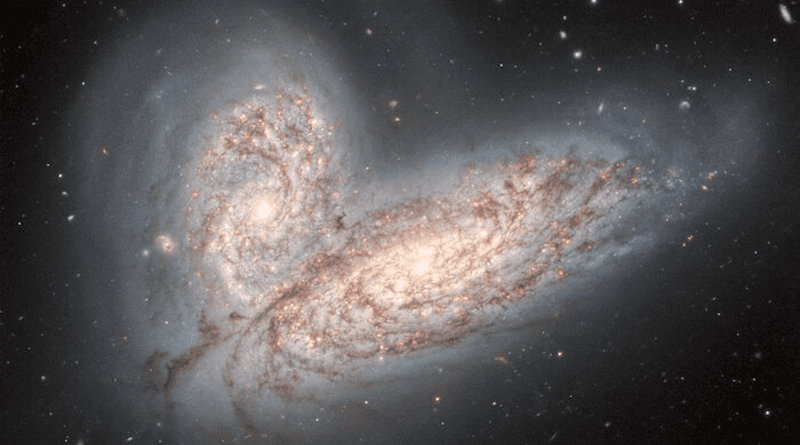Galaxy Mergers Shed Light On Galactic Evolution Model
An Australian astronomer has solved a century-old mystery regarding how galaxies evolve from one type to another. The same study shows that the Milky Way, the galaxy we live in, was not always a spiral. The work by Professor Alister Graham from Swinburne Astronomy Online uses new and old insights and observations to reveal how galaxy speciation occurs. The research appears in Monthly Notices of the Royal Astronomical Society.
In the 1920s and 1930s, astronomer Edwin Hubble and others established a sequence of varying galaxy anatomy, now known as the Hubble sequence or the Hubble tuning fork diagram. It lacks evolutionary pathways but is still widely used to classify galaxies based on their visual appearance.
Galaxies can contain billions of stars orderly following circular orbits in a crowded disc or chaotically buzzing about in a spherical or ellipse-shaped swarm. These discs can host spiral patterns, with such spiral galaxies defining one end of the long-standing Hubble sequence.
In this sequence, lentil-shaped galaxies, known as lenticular galaxies with a central spherical structure in a spiral-less disc, were considered the bridging population between disc-dominated spiral galaxies like our Milky Way and elliptical-shaped galaxies like M87.
In the new study, Professor Graham analysed optical images from the Hubble Space Telescope and infrared images from the Spitzer Space Telescope of 100 nearby galaxies. By comparing their stellar and central black hole mass, he discovered two types of lenticular galaxies: old and dust-poor, and dust-rich.
The dust-rich lenticular galaxies are built from mergers of spiral galaxies. Spiral galaxies can have a small central spheroid plus a disc containing spiral arms of stars, gas and dust winding out from the centre. The dusty lenticular galaxies have notably more prominent spheroids and black holes than the spiral galaxies and the dust-poor lenticular galaxies.
In a turn of events, Professor Graham’s research has shown that spiral galaxies reside midway between the two types of lentil-shaped galaxies.
“This re-draws our much-loved galaxy sequence,” says Professor Graham, “and, importantly, we now see the evolutionary pathways through a galaxy wedding sequence, or what business might refer to as acquisitions and mergers.”
If the dust-poor lenticular galaxies accrete gas and material, this can gravitationally disturb their disc, inducing a spiral pattern and fuelling star formation, changing their structure and shape.
The Milky Way has several smaller satellite galaxies, such as Sagittarius and Canis Major, and its structure reveals a rich history of acquisitions. The Milky Way was likely once a dust-poor lenticular galaxy that accreted material, including the Gaia Sausage-Enceladus satellite, and over time it evolved into the spiral galaxy we live in today. Deep imaging by countless ground-based telescopes over recent years has shown this is a feature common to spiral galaxies.
Some acquisitions will be more dramatic. Such a marriage is on the cards in 4 to 6 billion years when the Milky Way and the Andromeda galaxy collide.
Their collision will destroy the current spiral patterns in both galaxies, yielding a merged galaxy with a more-dominant spheroid, throw up a lot of dust clouds, and be accompanied by an increase in the central black hole mass. It will lead to the birth of a dust-rich lenticular galaxy.
The subsequent merger of two dusty lenticular galaxies appears sufficient to fully erase their discs and create an elliptical-shaped galaxy, unable to retain cold gas clouds harbouring dust.
In some ways, the dust-poor lenticular galaxies appear as a fossil record of the Universe’s primordial galaxies. These disc-dominated galaxies are very old and common. The merging of two of these in the young Universe may explain the recent observation by the James Webb Space Telescope of a massive spheroid-dominated galaxy when the Universe was 700 million years old. Furthermore, the new research has also revealed that merging two elliptical galaxies is sufficient to explain the Universe’s most massive galaxies today, observed at the centres of 1000-member galaxy clusters.
Professor Graham notes that many clues were known but had yet to be combined into a cohesive picture. He says, “Things fell into place once it was recognised that the lenticular galaxies are not the single bridging population they were long portrayed as.”
The new work means galaxies now have their family tree. “It’s survival of the fittest out there,” says Professor Graham, “which ultimately means the reign of spheroids over discs.” He adds, “Astronomy now has a new anatomy sequence and finally an evolutionary sequence in which galaxy speciation is seen to occur through the inevitable marriage of galaxies ordained by gravity.”

